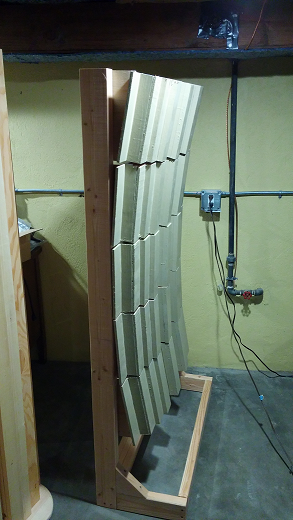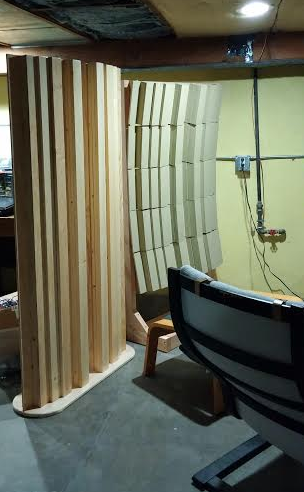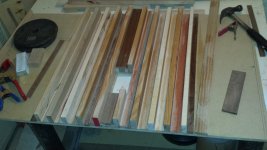In my last HT, i made skylines out of the blue styrofoam from Lowes. I used a hotwire cutter and they "looked" great. I was totally unaware that calculators exsist for proper design implementation. Not sure the styrofoam is good material for reflecting sound. Maybe if i spray coated with a solid material, but then there is still the issue of foam and the lower frequencies......so, i like these wood diffusers
My most recent diffusors diffuse horizontally, but are otherwise concave curved to concentrate (but still time-diffuse) vertically. (See the article in Linear Audio 11). I use these to catch the back-wave that goes past the listening position to provide a good strong late diffuse arrival. They are much more effective than the non-curved versions (the arrival is about 9dB stronger).




Last edited:
I love this thread.
I've been working on some of my own. I'm fitting this one onto a .25" MDF backer that should be plenty rigid enough once all the hardwood pieces are glued and screwed in place. I'll include a pic if you never caught it in the neighboring posts.
The MDF I used had a slight curvature in it from sitting on its end. For some reason I thought that might possibly add to its effectiveness enabling it to catch more sound waves more easily being slightly up away from the wall. Not being sure on it I took it out.
Some of my wood pieces were already cut and only having so much at the time I picked a minimum and cut others to size based around those so I'd have enough. If the channels aren't enough I will make one or two to purpose front and center. Only next time I will use a less expensive material and copy the better sounding. The higher frequencies needed attention I thought this one might just do the trick. Speaking of trick thats a chord hideaway built into the center. A flat screen will sit above and two amplifiers underneath for once I come up with an easy solution to hiding some of the wire
I've been working on some of my own. I'm fitting this one onto a .25" MDF backer that should be plenty rigid enough once all the hardwood pieces are glued and screwed in place. I'll include a pic if you never caught it in the neighboring posts.
The MDF I used had a slight curvature in it from sitting on its end. For some reason I thought that might possibly add to its effectiveness enabling it to catch more sound waves more easily being slightly up away from the wall. Not being sure on it I took it out.
Some of my wood pieces were already cut and only having so much at the time I picked a minimum and cut others to size based around those so I'd have enough. If the channels aren't enough I will make one or two to purpose front and center. Only next time I will use a less expensive material and copy the better sounding. The higher frequencies needed attention I thought this one might just do the trick. Speaking of trick thats a chord hideaway built into the center. A flat screen will sit above and two amplifiers underneath for once I come up with an easy solution to hiding some of the wire
Attachments
My most recent diffusors diffuse horizontally, but are otherwise concave curved to concentrate (but still time-diffuse) vertically. (See the article in Linear Audio 11). I use these to catch the back-wave that goes past the listening position to provide a good strong late diffuse arrival. They are much more effective than the non-curved versions (the arrival is about 9dB stronger).


The arrival is 9db strong ? Could i bother you to explain please :0)
9dB strongER. LATE arrival. Than from the noncurved diffuser.
It's because rather than letting the wavefront that reaches it continue to expand (toward floor and ceiling), it concentrates it toward the listener. Vertically that is -- horizontally it diffuses as usual. The idea is to get a strong enough late diffuse arrival for a "live end/dead end" effect without covering all the back walls with big diffusors.
Make sense?
It's because rather than letting the wavefront that reaches it continue to expand (toward floor and ceiling), it concentrates it toward the listener. Vertically that is -- horizontally it diffuses as usual. The idea is to get a strong enough late diffuse arrival for a "live end/dead end" effect without covering all the back walls with big diffusors.
Make sense?
Last edited:
Well, here is a graph of log-magnitude of room impulse response (very similar to the usual Time-Energy-Curve) measured using the original (non-curved) DepotDiffusor. The late arrival is at about 13msec on the plot:

Here is the same with the curved "CoFusor"

Notice how all the stuff just past 13msec is taller? There's no vertical scale on the graph, so you'll have to take my word on it that the stuff just after 13msec is about 9dB higher than in the first plot.
(There's a dB scaled plot of Time-Energy-Curve in the article in Linear Audio, but I don't want to be posting a lot of stuff here that is directly from the article. Jan probably wouldn't like that!).

Here is the same with the curved "CoFusor"

Notice how all the stuff just past 13msec is taller? There's no vertical scale on the graph, so you'll have to take my word on it that the stuff just after 13msec is about 9dB higher than in the first plot.
(There's a dB scaled plot of Time-Energy-Curve in the article in Linear Audio, but I don't want to be posting a lot of stuff here that is directly from the article. Jan probably wouldn't like that!).
The segments look to have an angle of less than 10 degrees, with the top/bottom ones about 15 - is this angle significant or just set by the distance to the speakers or front wall
Each Panel looks to be about 400mm (15") high? I wonder, with a bit of finessing to make a 'stiff' hot knife cutting blade, if it would be at all beneficial to make these 'segments' with a curve cut into the surface (with styrene) or just dreaming?
With thicker styrene, could cut each of the 5 'segments' to different depths so not need an adjusting back panel, just thicker styrene 'blocks' - ie, 3 different cross sections on the 1 simple back board for the 5 reflective/diffusing surfaces
Each Panel looks to be about 400mm (15") high? I wonder, with a bit of finessing to make a 'stiff' hot knife cutting blade, if it would be at all beneficial to make these 'segments' with a curve cut into the surface (with styrene) or just dreaming?
With thicker styrene, could cut each of the 5 'segments' to different depths so not need an adjusting back panel, just thicker styrene 'blocks' - ie, 3 different cross sections on the 1 simple back board for the 5 reflective/diffusing surfaces
The angles are arranged so that a reflection from the speaker off the center of each segment (angle of incidence equals angle of reflection!) is directed toward the listener. Ideally, you base the angles on distance from speaker to cofusor and distance from cofusor to listening position, and height of the segment. I made a spreadsheet to calculate the boards needed to direct each segment, though the ones I made were done more seat-of-the-pants with more crude calulations -- but still worked pretty well. Just the fact that you are turning a spreading wavefront into a converging wavefront gets you quite a lot!
Its like a concave mirror, but with sound waves...
Its like a concave mirror, but with sound waves...
So, a focussed diffuser (that's a bit of a contradiction!)
By decreasing the height of the diffused energy, this 'should' increase the horizontal diffusion and also improve the DI (directivity index (O'Toole, etc)
However, on second thoughts, by reducing the vertical diffusion, this also reduces the indirect reflections off the ceiling and as this is a major source of 'first reflected signal', it may actually be counter productive to 'focus' the vertical diffusion - it sound weird to talk about controlling the 'spread' of a diffuser
Anyway, it looks fairly simple to try - I'll add this to the list...
Oh, those ceilings - I wonder if there's a way to design a series of long and crossed (longitude and latitude) smaller leanfuser panels to replace the ceiling 'skyline' 2D diffusers (they work well but look bloody awful!) - maybe a series of 18" modules?
Mind you, it's rare to see a domestic hifi room that has treated the ceiling as all and that's usually with absorbers only
By decreasing the height of the diffused energy, this 'should' increase the horizontal diffusion and also improve the DI (directivity index (O'Toole, etc)
However, on second thoughts, by reducing the vertical diffusion, this also reduces the indirect reflections off the ceiling and as this is a major source of 'first reflected signal', it may actually be counter productive to 'focus' the vertical diffusion - it sound weird to talk about controlling the 'spread' of a diffuser
Anyway, it looks fairly simple to try - I'll add this to the list...
Oh, those ceilings - I wonder if there's a way to design a series of long and crossed (longitude and latitude) smaller leanfuser panels to replace the ceiling 'skyline' 2D diffusers (they work well but look bloody awful!) - maybe a series of 18" modules?
Mind you, it's rare to see a domestic hifi room that has treated the ceiling as all and that's usually with absorbers only
Maybe this is a completely awful idea, but what if i used these on the rear theater wall, and made the middle a little wider and put my back speakers in there, then cover the whole thing with speaker cloth??
How bad would the additional gap in the middle decrease the effectiveness?
How bad would the additional gap in the middle decrease the effectiveness?
...I looked at the 5 module design for the first reflection points but need them to be mobile (window areas) so thinking of cutting styrene foam sheets to reduce weight and instead of gluing thin 3mm ply to the flat surfaces, thought about using venetian blind slats as they're already fully finished surfaces, but are only 50mm wide [50mm wide x 3mm thick x 'whatever' high]
I have been working on my absobers so I have still not gotten to the diffusion yet.
The 'paper lantern diffuser' concept has taken a turn away from threading paper through a frame of dowels. I am now leaning toward the alternate concept of kraft paper over chicken wire frame with the advent of the following:
- bought the 30" wide kraft paper to face absorbers in the 'soffit' above kitchen cabinets
- bought the 36" wide chicken wire to experiment with bending it
- bought two steel 48" long angles to clamp the chicken wire between
- tried hand-bending with fingers/pliers, and with the angles/C clamps method (both seem to work fine, the wire bends readily either way)
- sort-of tested the bandwidth of the kraft and determined that it pretty much agrees with theory, cutting off at about the same frequency as the DIY diffuser
It is very inexpensive and simple to build. It requires only paper, chicken wire, and hot glue.
The diffuser is light enough to be pinned to the wall or ceiling with tacks, incorporated into or supported by any movable structure such as a folding screen/partition, hang from clear plastic fishing line, and/or easily aimed by bending at its wall/ceiling attachment points. It can probably also be formed into an arc fairly easily by bending the finished wire frame and using separated pieces of kraft at the 90 degree bends between front-facing and sideways-facing surfaces. In 36" tall 'chicken wire height' increments, an approximated arc from three stacked and angled panels may suffice just fine.
The diffuser can be easily painted with a single coating from air brush/sprayer, or constructed from any thick paper that already has any desired printed pattern. The attachment to the chicken wire frame is simple and instant with hot glue or spray adhesive.
The diffuser can also serve as the front surface of a corner bass trap or be hung in front of an absorption-type bass trap to preserve ambiance without reflecting bass.
I am almost done with the absorbers so the diffusers should be next in line. My plan is to very lightly score the paper with a sharp-ish but not cutting object such as butter knife, and hot glue to a chicken wire frame that will be bent by clamping it between steel angles to keep a straight line, and fine-tuned to square angles with the use of fingers.
The one remaining question I have is how much space to leave between a diffuser and the listener. I have seen claims of 10' but I have also seen drawings of listening rooms with 8-9' ceilings and diffusers directly above the MLP so I am sort of confused about the minimum distance required for diffusion to work its magic, whereas any closer distance negates any benefit? Is it bandwidth-dependent? What about 500Hz cutoff for this specific DIY diffuser contour vs. minimum distance to the listener?
Pity that you can't cover them with even an acoustically transparent cloth (this stops them acting as diffusers unfortunately) as they're a PIA to keep clean - it must be the static electricity of the styrene or something but they seem to just attract dust, lint and everything here.
By definition, 'acoustically transparent' means it does not affect the sound. I am having difficulty resolving your statement with theory. Even front sound stage can propagate through AT screen acceptably with no issues other than slight treble attenuation that can be fixed if desired using a little EQ, and good speaker cloth is next to nothingness across the audio band.
A simple curved panel will still give a more-or-less specular reflection, so the diffused waveshape will be very similar to the direct one. Step or well diffusors diffuse both in direction and in time (waves are broken up per frequency), while a curved panel will only diffuse in direction. Is that better or worse? I'd go with step diffusor but haven't really tried both.
What about s-shaped ceiling diffuser?
I was looking for a solution to a problem. On my L&R side walls of my HT i have two onwall sidesurrounds. They face each other, and are about 13' apart. My concern is the slap echo/flutter between these walls and the fact that the speakers basically beam toward each other.
Would this be a good location for this type diffuser ? The room is LEDE, and maintaining energy that is diffused in the LiveEnd would be a great way, if im correct.
I am facing this issue also, although it is not so much LEDE as 'this stuff barely fits in here' with first reflection off rear/ceiling/side and corner bass traps the only absorption. Even so, the room treble is attenuated and I have to keep the absorbers deep in the corners and kraft faced to avoid that totally stuffy feel.
So temporarily I hung a string of two pillow cases pinned together behind one side surround tower to soak up a little of the slap echo. It does not take much to tame it. I will be trying some diffusion later.
If you have similar issue with ambience being soaked up diffusion may be much better.
Thank you so much for explaining. Will they work horizontal ? I could really use them above, below, beside my first reflection point absorbers ?
You should probably cut them to size and install them with slats oriented vertically.
You might also want to angle them toward the listener if they are high up/low down.
Maybe this is a completely awful idea, but what if i used these on the rear theater wall, and made the middle a little wider and put my back speakers in there, then cover the whole thing with speaker cloth??
How bad would the additional gap in the middle decrease the effectiveness?
You would need to model it and the effect will be frequency-dependent. Just go for it.
- Home
- General Interest
- Room Acoustics & Mods
- Making easy DIY "Depot" sound Diffuser panels, step by step
